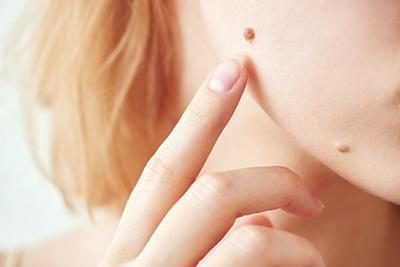
Moles are pigmented growths on the surface of the skin that are usually harmless. However, a mole can become cancerous, especially with repeated sun exposure, so it is important to regularly check moles for changes. Identifying suspicious changes right away helps lead to early detection of cancer when it is more easily treated. Dr. Indira Misra-Higgins, the experienced dermatologist at Beverly Hills Skin Care Institute in Beverly Hills, MI, screens moles for signs of skin cancer.
Moles and Skin Cancer Warning Signs
Most moles are usually benign, but a mole can develop melanoma — a rare but serious form of skin cancer. Melanoma is curable when caught early, but can be deadly once it advances to the later changes. Monitoring existing moles for suspicious changes is extremely important as it aids in the early detection of melanoma and other skin cancers.
The ABCDE guide is a simple way to remember what types of changes or characteristics to look for when examining your moles. ABCDE is an acronym for asymmetry, border, color, diameter, and evolving. Contact a dermatologist if you observe any of the following suspicious changes in your moles:
- Asymmetry — Moles are typically symmetrical in color, size, and shape. A mole being asymmetrical from one side to the other is a warning sign of skin cancer.
- Border — The border or edges of a mole should be well-defined. A poorly defined, scalloped, or irregular border is another warning sign of skin cancer.
- Color — Moles should be a consistent color throughout. One warning sign of skin cancer is an inconsistent color, such as brown with black dots.
- Diameter — Benign moles are typically smaller than 1/4 inch or 6mm in diameter, which is about the size of an eraser on the end of a pencil. Moles with a diameter that is larger than 6mm have a higher risk of being cancerous.
- Evolving — Normal, healthy moles do not change much, if at all, over time. A change in the shape, size, color, or texture is a sign of possible cancer.
Mole Removal
Moles that have developed suspicious changes or are at risk for developing cancer can be safely and easily removed by a dermatologist. Four methods commonly utilized for removing suspicious moles at our office in Beverly Hills, MI, include:
- Freezing — Liquid nitrogen is applied to the mole to freeze it off.
- Burning — An electric current is used to burn off the upper layers of the mole.
- Shaving — A surgical blade is used to carefully have off the surface of the mole.
- Excision — A surgical blade is used to remove the entire mole and requires the skin to be stitched closed afterward. This method is used for cancerous moles.
It is extremely important to examine your moles regularly so that suspicious changes can be identified right away. Skin cancer is easiest to treat when it is detected early. Schedule an appointment with Dr. Misra-Higgins for a skin cancer screening of your moles by calling the Beverly Hills Skin Care Institute in Beverly Hills, MI, at (248) 723-5802.
